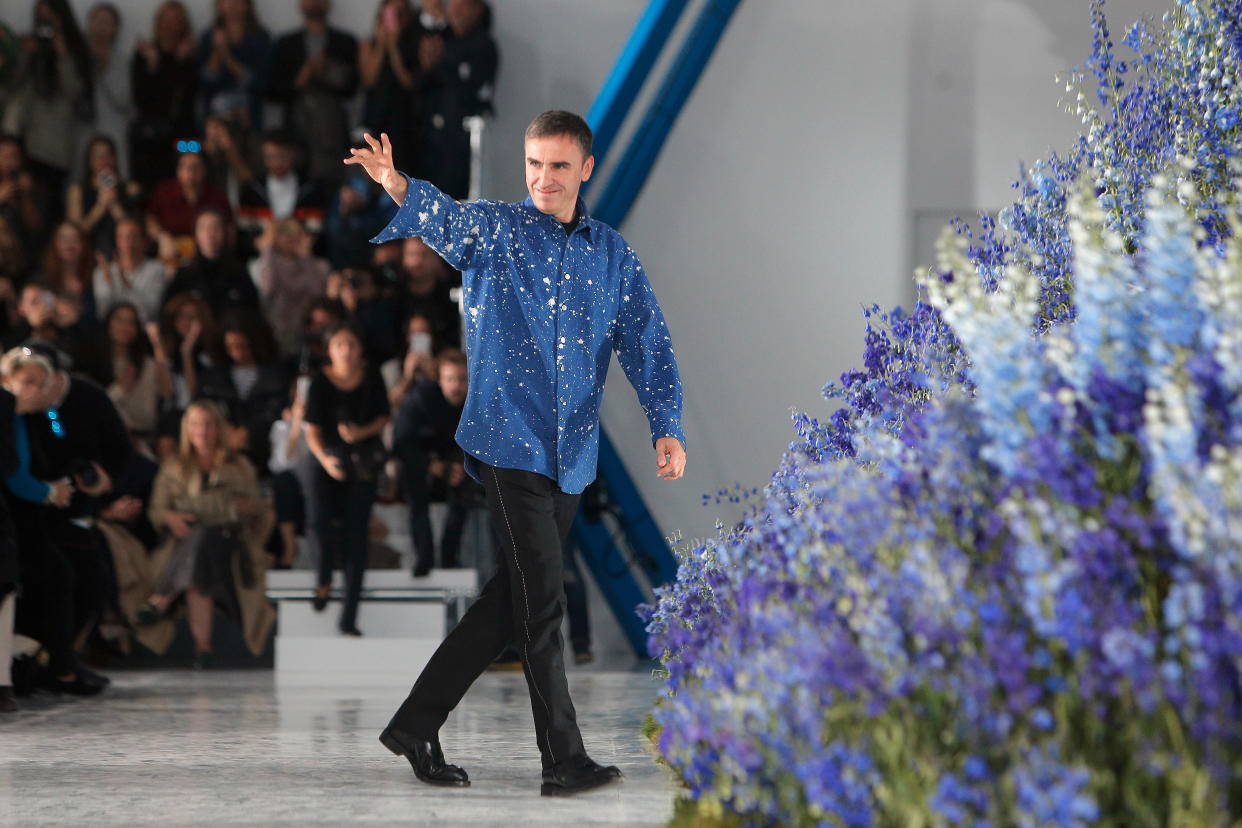Why Raf Simons is leaving Christian Dior

Raf Simons is leaving Christian Dior.
Sidney Toledano, the chief executive officer of the Paris fashion house, made the announcement today in a statement. The decision by Simons, 47, not to renew his contract is surprising. Since he took over in April 2012, Dior has prospered under his creative control. And Simons seemed to thrive, too: For once in the gossipy world of fashion, there were no rumors of a rift or whispers that Simons would leave.
Quite the contrary, in fact. After Dior's spring show in Paris on October 2 — Simons's last, as it turns out — Bernard Arnault, the chairman of LVMH, was backstage praising the designer, although he had already told Arnault and Toledano that he planned to leave. Simons has always had a warm relationship with both men and with Arnault's daughter, Delphine, who was involved in his hiring. He gave Dior's rich, romantic legacy — the full skirts, the fitted Bar jacket, the flowers — a modern edge, and without the drama and personal excess of his predecessor John Galliano, who was fired in 2011. Indeed, Simons's tightrope walk between realness and high fashion not only felt new and directional, it also helped fuel a 60 percent rise in sales since 2011, as Toledano recently told a French newspaper. For the most recent fiscal year, revenues at Christian Dior Couture were up 18 percent, to $1.94 billion. For those reasons and others, Toledano and Arnault tried over the summer and into September to persuade Simons to stay.

So what's behind his decision? And what will Simons and Dior do next?
The second question won't have answers for some time. Simons, who was unavailable for comment, will likely focus on his avant-garde men's label, based in Antwerp. He no doubt has a noncompete agreement with Dior that will prohibit him from working for another brand for some months, possibly a year. Almost certainly he'll want to do women's fashion again, perhaps with a different set of challenges than he had at Dior or Jil Sander, where he worked from 2005 to 2011.
Who will succeed him at Dior? Lots of names will surface. One is Givenchy's Riccardo Tisci. His show in New York in September, attended by top LVMH executives, seemed a platform for a major career move. But is his dark, religion-infused aesthetic right for pretty Dior? And can Toledano strike a rapport with Tisci, as he did so easily with Simons? Another possibility is Phoebe Philo of Céline. Her women-friendly clothes cause a buzz, and she's a master of accessories, but while it would be fascinating to see a woman at Dior, the London-based Philo may resist the idea of spending more time in Paris — and being responsible for many more shows than she now is at Céline.
And that leads us back to the first question: Why? Although Simons seldom voiced regret in interviews about the workload at Dior — six shows a year, two involving the extra finesse of haute couture — he was candid about the pressures it put on the creative process. Galliano's downfall made people question the amount of stress designers are under, but that wasn't Simons's complaint. He certainly talked about stress, but he had enough personal resources to handle it — a stable private life, close friendships that go back 35 years, an overriding sense of duty toward Dior and the people in its ateliers. This last was evident in Dior and I, the documentary that was shot during his first season as artistic director. He was uncomfortable with the old formalities of couture, like being addressed as "monsieur." He didn't want to feel isolated, nor make fashion that was out of touch. As Toledano said to the staff in the film, "Let's call him Raf, as a token of modernity."
Click through below to see the most recent Dior collection:
But Simons was frustrated by the lack of time to create. For his debut show, in July 2012, he had eight weeks to prepare, but that was soon cut in half, given other demands on his schedule. That was okay, he told me a few months ago during an interview for System magazine that will appear in early November, because Dior's workrooms and their network of suppliers could turn things out at amazing speed. But as he said then, "When you do six shows a year, there's not enough time for the whole process. Technically, yes — the people who make the samples, do the stitching, they can do it. But you have no incubation time for ideas, and incubation time is very important. When you try an idea, you look at it and think, Hmm, let's put it away for a week and think about it later. But that's never possible when you have only one team working on all the collections."
His solution was to form two design studios last year, so that they alternated on the collections. That helped a lot, he said, but he still seemed to question the value of producing so many shows, and if it was just self-deluding to think that fresh ideas could emerge at such a pace. "Because I'm not the kind of person who likes to do things so fast," Simons said. "I think if I had more time, I would reject more things, and bring other ideas or concepts in." He added, "I think I can deal with the highest level of expectation within the business, like massive blockbuster shows, commercial clothes, big concepts. But I don't think that necessarily makes you a better designer."
Maybe, but one could argue otherwise — that the pressure of Dior made Simons more proficient, more intuitive. His last haute couture collection, in July, imposed a kind of Flemish stillness on Dior's New Look volumes, resulting in serenely plain gowns worn with almost decadent cape-coats. Simons said it was his favorite show. It also had a perceptible influence on the New York collections in September, leading to a flock of Guinevere dresses.
Yet despite Dior's unlimited artistry and a great deal of freedom to reinvent its fashion, Simons's creative control didn't extend everywhere, and that may have gnawed at him, too. Some areas, like store design, were out of his hands. There has long been a slight disconnect between Dior's runway image and the image of the brand presented in, say, its celebrity perfume ads — a gap that was actually wider and weirder in the early Galliano years. Philo, by contrast, seems to have a lot of say in Céline's overall image — from advertising to the intimate scale of her shows to the cool elegance of the company's new Paris showrooms. But Dior is a much larger, more complex business — the pride of Arnault, a virtual fiefdom on Avenue Montaigne — and it seems unlikely that one individual, however willing and admired, would ever be given too much power.
So perhaps, after three and a half years at Dior, Simons felt it was not the best place for him. Does walking away from one of the great Paris houses amount to a rejection of the model of the past 20 years — the big-show, high-profile luxury brand? No, that would be an exaggeration. But it does suggest that the even-tempered Simons is seeking a better sense of proportion — fewer shows, more time to create — and with it, greater control and personal satisfaction.
More from The Cut:
Raf Simons' 30 Best Looks at Dior
Zendaya Gets Photoshopped, Slams Magazine for Promoting Unrealistic Beauty Ideals
Woman Documents a Decade's Worth of Messages From Creepy Dudes
